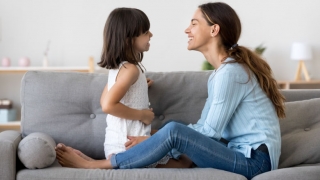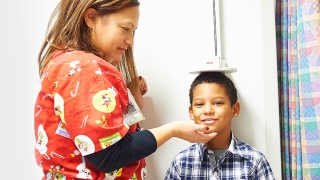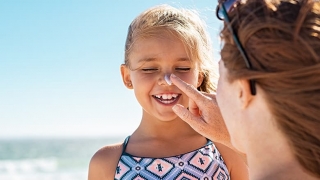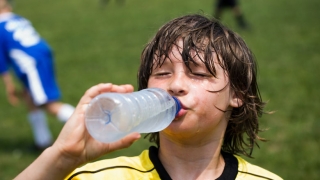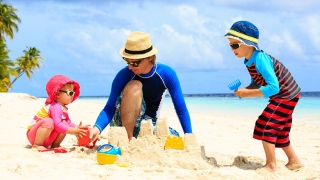Sunburn and Children
What is sunburn?
Sunburn is a visible reaction of the skin's exposure to ultraviolet (UV) radiation or UV light sources (invisible rays that are part of sunlight) such as tanning salons. Ultraviolet rays can also cause invisible damage to the skin. Excessive and/or multiple sunburns cause premature aging of the skin and lead to skin cancer. Skin cancer is the most common type of cancer in the US and exposure to the sun is the leading cause of skin cancer.
Children often spend a good part of their day playing outdoors in the sun, especially during the summer. Children who have fair skin, moles, or freckles, or who have a family history of skin cancer, are more likely to develop skin cancer in later years.
Exposure to the sun during daily activities and play causes the most sun damage. Overexposure to sunlight before age 18 is most damaging to the skin.
UV rays are strongest during summer months when the sun is directly overhead (normally between 10 a.m. and 4 p.m.).
What are the symptoms of sunburn?
The following are the most common symptoms of sunburn. However, each child may experience symptoms differently. Symptoms may include:
-
Redness
-
Swelling of the skin
-
Pain
-
Blisters
-
Fever
-
Chills
-
Weakness, confusion, or faintness
-
Dry, itching, and peeling skin days after the burn
The symptoms of sunburn may resemble other skin conditions. Always consult your child's primary care provider for a diagnosis.
First aid for sunburn
-
Have your child take a cool bath or use cool compresses on the sunburned area.
-
Give your child acetaminophen or ibuprofen for discomfort. Be sure to follow the directions on the container.
-
Apply a topical moisturizer, aloe gel, hydrocortisone cream, or a topical pain reliever to sunburned skin.
-
If blisters are present, do not break them open, as infection can occur.
-
Keep your child out of the sun until the burn is healed.
-
Give your child extra fluid for several days to avoid dehydration.
When should I call my child's primary care provider?
Specific treatment for sunburn will be determined by your child's primary care provider and may depend on the severity of the sunburn. In general, call your child's primary care provider if:
-
The sunburn is severe or forms blisters.
-
Your child has symptoms of heat stress such as fever, chills, nausea, vomiting, or feeling faint.
Preventing sunburn
Protection from the sun should start at birth and continue throughout your child's life.
The best way to prevent sunburn in children over 6 months of age is to follow the A, B, Cs recommended by The American Academy of Dermatology:
|
Away |
Stay away from the sun in the middle of the day. This is when the sun's rays are the most damaging. |
|---|---|
|
Block |
Block the sun's rays using a SPF 30 or higher sunscreen. Apply the sunscreen at least 30 minutes before going outside and reapply it often during the day. Sunscreens should not be used on infants under 6 months of age. However, when adequate clothing and shade are not available, a minimal amount of sunscreen with at least 15 SPF can be applied to small areas, such as the infant's face and the back of the hands. |
|
Cover-up |
Cover up using protective clothing, such as a long sleeve shirt and hat when in the sun. Use clothing with a tight weave to keep out as much sunlight as possible. Keep babies less than 6 months old out of direct sunlight. Sunglasses and hats with brims are important. |
What are sunscreens?
Sunscreens protect the skin against sunburns and play an important role in blocking the penetration of ultraviolet (UV) radiation. However, no sunscreen blocks UV radiation 100 percent.
Terms used on sunscreen labels can be confusing. The protection provided by a sunscreen is indicated by the sun protection factor (SPF) listed on the product label. A product with an SPF higher than 15 is called a sunblock.
How to use sunscreens
A sunscreen protects from sunburn and minimizes suntan by absorbing UV rays. Using sunscreens correctly is important in protecting the skin. Consider the following recommendations:
-
Choose a sunscreen for children and test it on your child's wrist before using. If your child develops skin or eye irritation, choose another brand. Apply the sunscreen very carefully around the eyes.
-
Choose a broad-spectrum sunscreen that filters out both ultraviolet A (UVA) and ultraviolet B (UVB) rays.
-
Apply sunscreens to all exposed areas of skin, including those easily overlooked areas, such as the rims of the ears, the lips, the back of the neck, and tops of the feet.
-
Use sunscreens for all children over 6 months of age, regardless of skin or complexion type, because all skin types need protection from UV rays. Even dark-skinned children can have painful sunburns.
-
Apply sunscreens 30 minutes before going out into the sun to give it time to work. Use it liberally and reapply it every two hours after being in the water or after exercising or sweating. Sunscreens are not just for the beach. Use them when your child is playing outdoors in the yard or participating in sports.
-
Use a waterproof or water-resistant sunscreen.
-
Use of a sunscreen with SPF of 30 or higher offers substantial protection from sunburn. High SPF sunscreens protect from burning for longer periods of time than do sunscreens with lower a SPF. Talk with your older child or teenager about using sunscreen and why it's important. Set a good example for them by using sunscreen yourself.
-
Teach your teenager to avoid tanning beds and salons. Most tanning beds and salons use ultraviolet-A bulbs. Research has shown that UVA rays may contribute to premature aging of the skin and skin cancer.
-
For children younger than 6 months, parents should still try to avoid sun exposure and dress the child in lightweight clothing that covers most surface areas of skin.
Always consult your child's primary care provider for more information.
Reviewed by Elena Huang, MD, FAAP
